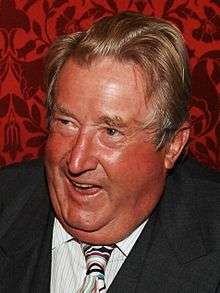Sir William McAlpine, 6th Baronet
| The Honourable Sir William Hepburn McAlpine Bt FRSE | |
|---|---|
 | |
| Born |
12 January 1936 Dorchester Hotel, London, England |
| Died | 4 March 2018 (aged 82) |
| Nationality | British |
| Occupation | Businessman |
| Spouse(s) |
Jill Benton Jones [1](m. 1959; her death 2004) Lady Judith McAlpine (m. 2004; his death 2018) |
| Children | 2 |
Sir William Hepburn McAlpine, 6th Baronet, FRSE (12 January 1936 – 4 March 2018) was a British businessman who was director of the construction company Sir Robert McAlpine.
Biography
Born in London in 1936 at the family-owned Dorchester Hotel,[2] McAlpine was the oldest son of Sir Edwin McAlpine, 5th Bt (who was given a life peerage as Lord McAlpine of Moffat in 1980) by his marriage to Ella Mary Gardner Garnett.[2] His great-grandfather was "Concrete Bob", Sir Robert McAlpine, the first of the McAlpine baronets and the founder of the construction company. He had two younger brothers Alistair McAlpine, Baron McAlpine of West Green and David McAlpine.
Brought up at the family home in Surrey and educated at Charterhouse,[2] McAlpine joined the family firm from school, starting his career at the Hayes Depot in Middlesex, a 30-acre (120,000 m2) site which housed the McAlpine railway locomotive and wagon fleet. The years after the Second World War were a busy time for the construction industry.
He served in the Life Guards for two years from 1954.[3]
In 1990, on the death of his father, McAlpine inherited his baronetcy and became Sir William. He was patron of the Clan MacAlpine Society.[4] He served as High Sheriff of Buckinghamshire for 1999. He was a director and trustee of the educational charity Shiplake Court Limited.
In 2007 McAlpine was president of the Smeatonian Society of Civil Engineers to which he had been elected a member in 1985.
He was also the president of the Railway Benevolent Institution, known as the Railway Benefit Fund, a charity helping current and retired railway industry workers.
Fawley Hill Railway

An acknowledged railway enthusiast, he returned to Hayes depot during the Beeching Axe to find that the company's Hudswell Clarke 0-6-0ST No.31 was for sale for £100. He purchased the locomotive, and moved it to his country estate home at Fawley, Buckinghamshire.[5] This marked the start in 1961 of the 4 ft 8 1⁄2 in (1,435 mm) standard gauge Fawley Hill Railway, a private railway which now runs to over a mile long, combining the steepest gradient at 1:13 on a British railway, and includes:[6]
- The GER railway station from Somersham
- Midland Railway signal box from Shobnall Maltings, near Burton upon Trent
- The footbridge from Brading on the Isle of Wight, Bridge No 25, where it spanned the Ryde Pier to Shanklin line
In addition, the perimeter of the railway line is adorned with several prominent architectural features which McAlpine acquired – although these were received mostly as donations; these include the original Wembley Stadium Twin Towers (Wembley) Flagpoles, some early cast-iron bridge parapets, and several arched structures from prominent London locations.
Entrance to Fawley Hill Railway is by invitation only on select days, usually during the summer period. Sir William's extensive private railway museum is maintained by volunteers.
Other railways
After starting Fawley Hill Railway, McAlpine purchased GWR 4073 Class 4079 Pendennis Castle in partnership with John Gretton, which was subsequently housed at Market Overton in Rutland.[2] After being moved to the Steamtown, she was sold to Rio Tinto and moved to Australia. In January 1973 McAlpine purchased LNER Class A3 4472 Flying Scotsman after a financially disastrous tour of North America, to save her from sale to an American consortium.[2]
McAlpine became involved in a plan to save the Romney, Hythe and Dymchurch Railway and became its chairman. After the efforts of Dr Peter Beet to preserve Carnforth LMS 10(A) shed, McAlpine bought shares in 1970, and then took the controlling interest from 1974 until 1987 in the visitor attraction that became Steamtown. McAlpine chaired the RH&DR, the Dart Valley Railway, and established and chaired the Railway Heritage Trust.[2]
British Rail Class 60 60008 of EWS was named in his honour.
Sir William was also a Patron of the Swanage Railway Trust, as well as President of the Transport Trust, the charity dedicated to the preservation of all modes of transport and its infrastructure.
Personal life
McAlpine's first wife Jill Benton Jones, whom he married on 31 October 1959, died on 9 February 2004.[1] They had two children:
- Sir Andrew William McAlpine, 7th Bt (born 22 November 1960)
- Lucinda Mary Jane McAlpine (born 19 June 1964)
He married his second wife, Judith, whom he had known for many years, on 25 March 2004 at the restored station on his private railway.
He died on 4 March 2018 and was succeeded in the baronetcy by his only son.[7]
Styles of address
- 1936–1980: Mr William H McAlpine
- 1980-1990: The Honourable William H McAlpine
- 1990–2018: The Honourable Sir William H McAlpine, Bt
| Baronetage of the United Kingdom | ||
|---|---|---|
| Preceded by Sir (Robert) Edwin McAlpine, 5th Baronet |
Baronet (of Knott Park) 1990–2018 |
Succeeded by Sir Andrew William McAlpine, 7th Baronet |
References
- 1 2 "Jill Benton Jones".
- 1 2 3 4 5 6 "Sir William McAlpine talks to Andy Milne". Railway people. 2006-06-20.
- ↑ "McAlpine, Hon. Sir William (Hepburn)". Who's Who online. Retrieved 24 March 2018. (subscription may be required or content may be available in libraries)
- ↑ Official Homepage of the Worldwide Organization for MacAlpines
- ↑ "Fawley". Hampton Court MRS. Archived from the original on 19 June 2013.
- ↑ "Fawley Museum Railway". Archived from the original on 25 September 2011.
- ↑ "Saviour of Flying Scotsman dies". Henley Standard. 5 March 2018. Retrieved 5 March 2018.